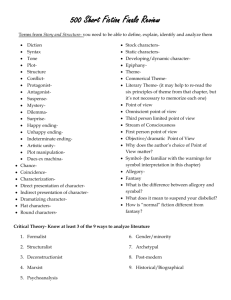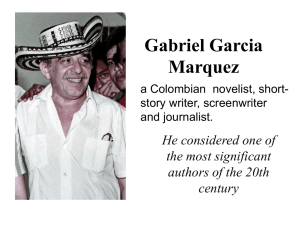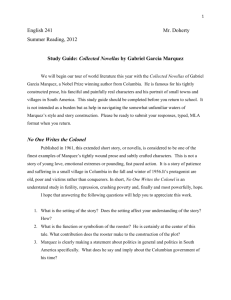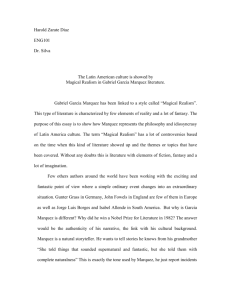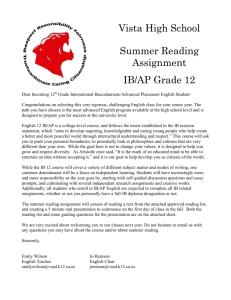Postcolonial Environments in Gabriel Garcia Marquez's
advertisement
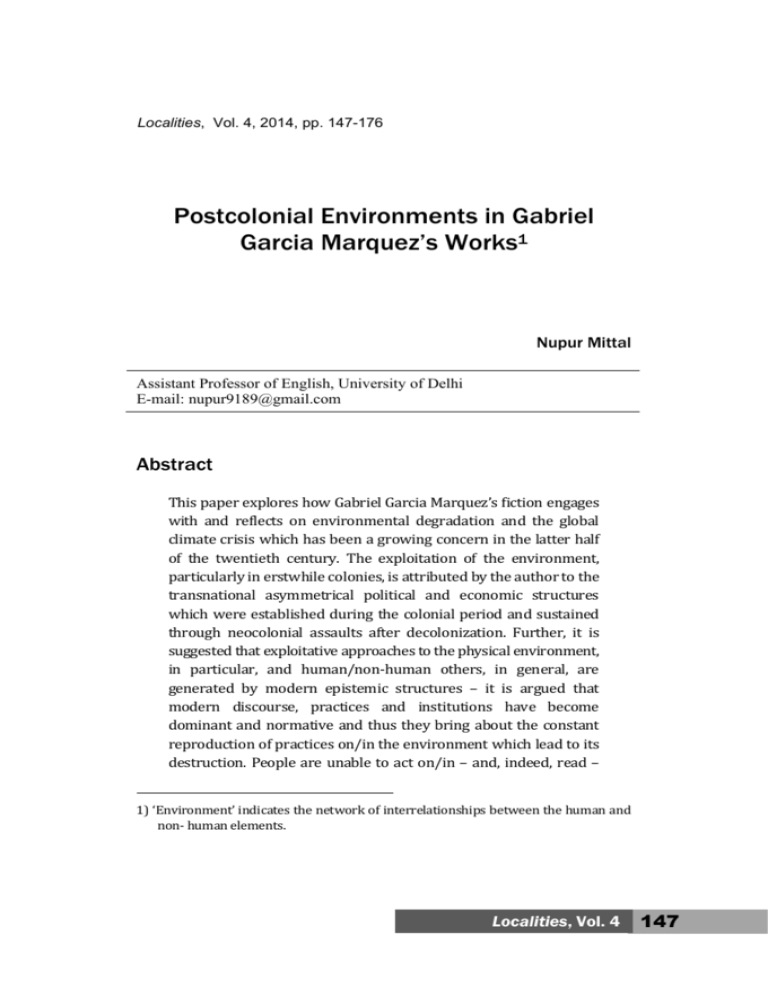
Localities, Vol. 4, 2014, pp. 147-176 Postcolonial Environments in Gabriel Garcia Marquez’s Works1 Nupur Mittal Assistant Professor of English, University of Delhi E-mail: nupur9189@gmail.com Abstract This paper explores how Gabriel Garcia Marquez’s fiction engages with and reflects on environmental degradation and the global climate crisis which has been a growing concern in the latter half of the twentieth century. The exploitation of the environment, particularly in erstwhile colonies, is attributed by the author to the transnational asymmetrical political and economic structures which were established during the colonial period and sustained through neocolonial assaults after decolonization. Further, it is suggested that exploitative approaches to the physical environment, in particular, and human/non‐human others, in general, are generated by modern epistemic structures – it is argued that modern discourse, practices and institutions have become dominant and normative and thus they bring about the constant reproduction of practices on/in the environment which lead to its destruction. People are unable to act on/in – and, indeed, read – 1) ‘Environment’ indicates the network of interrelationships between the human and non‐ human elements. Localities, Vol. 4 147 Nupur Mittal the environment in ways that are not going to lead to its exploitation. By wielding a magic realist mode which frames, probes and subverts some of the assumptions which undergird the proto‐ realist mode, Marquez denaturalizes the ‘rational’, ‘natural’ and ‘objective’ view of the environment – he exposes the ethnocentric underpinning of the same – thereby allowing people to admit the possibility of conceiving alternate ways of defining and being in the environment. Keywords: Marquez, Post-colonialism, Environment, Realism, Modernity “The scientific consensus around the proposition that the present crisis of climate change is man‐made forms the basis of what I have to say here”(197), states historian Dipesh Chakrabarty at the outset of his essay ‘The Climate of History: Four Theses’. He observes that growing awareness about climate change has impacted the way in which we conceptualize modernity(Chakrabarty 198‐199). Existing theories of the modern, globalizing world are inadequate, he explains, in “making sense of this planetary conjuncture within which humanity finds itself today” – they focus on investigating and engaging with man‐made social and political institutions, largely ignoring the manner in which social forces and structures are embedded in and impact the biophysical environment (Chakrabarty 199). Reflecting specifically on historiography, Chakrabarty claims that this dichotomization between the social world and the natural world is one that informs the discipline of history – the geographical environment is considered to form a largely unchanging backdrop to the quick transitions and 148 Localities, Vol. 4 Postcolonial Environments in Gabriel Garcia Marquez’s Works transformations that mark the social environment, and is, therefore omitted from historiography(Chakrabarty 201‐205). However, scientists researching on and writing about climate change have made observations about the human‐environment interaction which could disturb the given dichotomy – they insist that certain planetary “parametric conditions” which are vital for the survival of this planet are being disturbed by the cumulative and continuing impact of the global processes of socio‐economic modernization, underway for the last three hundred years (Chakrabarty 217). It is vital to study the impact of collective human activity on the environment “we have reached numbers and invented technologies that are on a scale large enough to have an impact on the planet itself…Humans began to acquire this agency only since the Industrial Revolution”(Chakrabarty 207). To address this crisis, Chakrabarty argues, it is vital to think of human beings as social, biological and geological agents2, and to expand the scope of the discipline of history beyond that of recorded human history, to “deep history…the combined genetic and cultural changes that created humanity over hundreds of [thousands of] years”(Chakrabarty 213). Furthermore, we need to explore not just the impact of the human species on the environment, but also vice versa – attempts to redress can only follow once we have fathomed the potential impact of environmental 2) Social agents: actors in/of/on society; biological agents: bodily drives and impulses shape our behavior, as does the impact of the physical environment and genetics; geological agents: collectively, the human species impacts planetary conditions. Localities, Vol. 4 149 Nupur Mittal changes on us. Chakrabarty’s explorations of the shifts needed in historiography to meet the demands of a world riven by an unprecedented environmental crisis, mirror efforts across different academic disciplines that seek to do the same. In the domain of literature, the last few decades have seen interesting interactions between postcolonial critiques of globalization and capitalist development, and ecocriticism. Let’s reflect on the two cultural movements before we proceed. Postcolonial criticism has been defined and practiced differently by critics of various ideological stripes – indeed even the descriptive label ‘postcolonial’ has been interpreted and used in different ways. Postcolonial scholars are united, however, by their attempts to engage with the cultural, socio‐ economic and political legacies of European imperialism. In agreement with contemporary postcolonial scholars such as Dipesh Chakrabarty and Robert Young3, this paper defines the term ‘postcolonial’ as the period following the commencement of colonization and not just the post‐decolonization period – transnational asymmetrical economic and political relations that were established during the colonial period have persist even after decolonization world over, particularly, through the processes of economic modernization and development. Ecocriticism, on the other hand, is a mode of literary criticism which “takes as its subject the interconnections between nature and culture, specifically the 3) See Chakrabarty, Dipesh, 2000; Provincializing Europe. Young, Robert, 1990. White Mythologies: writing history and the West. 150 Localities, Vol. 4 Postcolonial Environments in Gabriel Garcia Marquez’s Works cultural artifacts of language and literature… its mandate also extends to the fields of environmental philosophy and bioethics, where ‘as a theoretical discourse, [it] negotiates between the human and the nonhuman [worlds]” (Glotfelty xix). Ecocritical scholars have defined the environment differently, and have traced diverse – often diverging – accounts of interrelations between man and the environment. This paper is particularly interested in the insights about environment presentedby recent ecocritical works such as Upamanyu Pablo Mukherjee’s Postcolonial Environments (2010) and Helen Tiffin and Graham Huggan’s Postcolonial Ecocriticism (2010). Mukherjee, in his book, emphasises “the unavoidable intertwining of the terms ‘postcolonial’ and ‘environment’ as conceptual tools in our understanding of the state of the subcontinent, and…of Africa, Latin America and much of the rest of the world” – the environment network of “interrelationships between human and non‐human agents or actors” in the erstwhile colonies is marked by “intensified and sustained exploitation by a cartel composed of their own and ‘core’ metropolitan European/north American elites”(Mukherjee 5). The aforementioned scholars build on the work of postcolonial critics to note that not only did colonial modernity inaugurate the racist hierarchical world order, but it also engendered practices and ethical systems which led to the global natural crises. Postcolonial literatures have for their referents, peoples’ conceptions of – and their practices on/in – the postcolonial natural and social environments. Ecocriticially inflected postcolonial criticism Localities, Vol. 4 151 Nupur Mittal could help overcome environmental and politico‐economic exploitation, by identifying and subverting the ideas and assumptions engendered by colonial modernity which continue to undergird the dominant epistemic structures which generate and delimit our belief systems and practices. This paper will examine and outline the manner in which Colombian author Gabriel Garcia Marquez employs the magical realist mode in order to denaturalize the globally dominant, normative ways of relating to and acting in/ on nature, with a special focus on his literary works – the novel One Hundred Years of Solitude (1967); and the anthology of short stories Innocent Erendira and other stories (1978) – as well as his Nobel Prize Acceptance speech, ‘The Solitude of Latin America’ (1982). I. Gabriel Garcia Marquez begins his Nobel Prize acceptance speech, ‘The Solitude of Latin America’, by saying – Antonio Pigafetta, a Florentine navigator...wrote, upon his passage through our southern lands of America, a strictly accurate account that nonetheless resembles a venture into fantasy. In it he recorded that he had seen hogs with navels on their haunches, clawless birds whose hens laid eggs on the backs of their mates...of having seen a misbegotten creature with the head and ears of a mule, a camel's body, the legs of a deer and the whinny of a horse... This short and fascinating book, which 152 Localities, Vol. 4 Postcolonial Environments in Gabriel Garcia Marquez’s Works even then contained the seeds of our present‐day novels, is by no means the most staggering account of our reality in that age. The Chronicles of the Indies left us countless others. <Emphasis mine.> (“The Solitude” 1) Two different worldviews are embedded in the italicized sentence. One is Colombian Marquez’s worldview, where the traveller’s account of the beasts found in the region is “strictly accurate”. The other, is the European explorer’s worldview. What he sees defies ‘natural reality’, according to his expectations of what constitutes the ‘natural’, which, of course, is natural phenomenon and objects existing in or at the very least known and documented in the Western world. As a result, Pigafetta encodes his account in a manner which “resembles a venture into fantasy” – the unfamiliar, incomprehensible natural environment of Latin America seems to demand a new mode of representation. Which is why Marquez asserts that the “seeds” of the “present day” magic realist novels, like his own works, lie in the reports of the new world by early European explorers. The supernatural and the natural coexist in magic realism – by implication, the ‘natural’ is denaturalized, while the ‘supernatural’ is admitted to the realm of possibility. The terms ‘natural’ and ‘supernatural’ are placed within inverted commas, because Marquez does not take them for granted – there is no fixed perspective about what constitutes ‘natural’, and which would, by extension, help us identify and other as ‘supernatural’ all those elements that escape its confines. Before proceeding further, let us discuss anthropologist Johannes Localities, Vol. 4 153 Nupur Mittal Fabian’s insightful definition of the concept and process of Othering. Fabian, in his essay, ‘The Other revisited’ argues that ‘the Other’ is a vital epistemic category, the consciousness of which, inspires the human need to communicate and express. He states‐ “Recognizing another = alius as other = alter is a condition of communication and interaction, hence of participating in social‐cultural practices (or whatever sociological categories, from group to society, apply); or of sharing a Lebenswelt. Without alterity no culture, no Lebenswelt. This concept makes sense only if Lebenswelt exists in the plural” (The other revisited 9). Fabian outlines two kinds of ‘Others’ in the given essay – The Other within, whose alterity is constitutive of a given cultural universe; and the Other without – who is recognized as a member of a different cultural universe. In a bid to establish and sustain cultural supremacy over people belonging to non‐Western cultural groups, the relation that the colonial modern culture established with the non‐modern is consistent with the first definition of othering that Fabian proposes. Social science scholars across disciplines, theorizing the condition(s) of modernity, such as Chakrabarty, Prathama Banerjee, S.N. Eisenstadt etc. note that European colonizers, the self‐professed flag bearers of modernity, explained and neutralized the difference that they encountered in non‐Western cultures, by displacing them not spatially, but temporally – those who were different were simply not advanced or not modern enough. This made the transformation of their social structures appear to be as inevitable as the passage of time – and the process of their advancement was facilitated by 154 Localities, Vol. 4 Postcolonial Environments in Gabriel Garcia Marquez’s Works their colonial stewards who had already achieved the same in their own societies, thereby providing the non‐Western societies with a ready blueprint for their progress. Modern culture identifies as ‘backward’ and ‘primitive’ those people, belief systems and practices which are not consistent with its own ideologies, and readings and schemas of the world inconsistent with its own are identified as ‘irrational’. The supernatural, following this logic, would be a descriptive label employed to define (and dismiss from the realm of the natural) those elements and phenomenon which cannot be explained in terms of modern, Euro‐centric knowledge of nature. Marqeuz, in his speech, as we have seen, asserts that the “seeds” of the “present day” magic realist novels, like his own works, lie in the reports of the new world by early European explorers. His works (fiction as well as non‐fictional) force us to probe our understanding of the concepts ‘natural’ and ‘supernatural’, ‘real’ and ‘magical’ – in these terms lie implicit the cultural parameter(s) according to which a phenomenon is identified as one or the other. Before illustrating the foregoing argument it is necessary to recapitulate the tenets of realism, which emerged as the dominant literary mode of novelistic practice in the nineteenth century. Critics distinguish it from established literary traditions by drawing attention to its “formlessness” and use of non‐ embellished language(Watt 9). An influential account of realism is that of Marxist thinker György Lukács’ Studies in European Realism(1950), whose ideas about realism continue to shape theories about Localities, Vol. 4 155 Nupur Mittal poetics and relevance of realism. He explains that in a realist text the plot is driven by a dialectical interaction between the individual personality traits of the characters and their material socio‐economic realities. It is also shaped by the interrelationships and interactions of characters which are reflective of social interrelationships which in turn depend upon the historic stage at which the material, economic base structure of the society is. The final social vision of the text manages to surpass authorial intention and foresight, because the author grounds the characters, ideas and phenomenon that he includes, in the “objective” material realities which he observes.4 For a number of postcolonial novelists and/or literary critics, the transformative potential of realism lies in its ability to frame reality and compel us to perceive oppressive structures and unequal patterns of social interrelationships that form the context of the fiction – literary works operate, in this sense, as the sources for information or evidence on which social science disciplines or projects of social transformation may base their analysis and arguments. Marquez’s works, however, disturb this notion of objective reality. They underline the fact that an individual is engendered by a specific historical and social context where the sign systems available to him mold his perception of the reality (effect). In the novel, ‘natural’ and ‘supernatural’ episodes and subplots may be explained by analysing each of them in terms of 4) Lukács, György. ‘Preface’ Studies in European Realism: A Sociological Survey of the Writings of Balzac, Stendhal, Zola, Tolstoy, and Others. Anthologized in Dorothy J. Hale Ed. The novel: an anthology of criticism and theory, 1900–2000. Oxford: Blackwell publishing, 2006. 380‐ 393. 156 Localities, Vol. 4 Postcolonial Environments in Gabriel Garcia Marquez’s Works the culture whose world view they foreground and which generates them. However, there are certain episodes which cannot be similarly unpacked – they are metafictional in nature, and they comment on and disturb the assumptions which realist discourse is premised on. It is vital to remember that Marquez’s rendition of the genre of magical realism ‘writes back’5 to the conventional mode of literary realism. Before clarifying the reason for the employment of the phrase (‘writes back’), which commonly peppers postcolonial discourse, to describe Marquez’s poetics, it is necessary to look at one such metafictional episode in One Hundred years of Solitude. An insomnia plague strikes town, one of the side effects of which is amnesia. After contracting it, the townsmen gradually begin to forget names for everything. To remedy that, Colonel Aureliano Buendia fixes labels to all possible objects, bearing their names and instructions about how they are to be used – The Sign that he hung on the neck of the cow was an exemplary proof of the way in which the inhabitants of Macondo were prepared to fight against loss of memory: This is the cow. She must be milked every morning so that she will produce milk and the milk must be boiled in order to be mixed with coffee to make coffee and milk. Thus they went on living in a reality that was slipping away, momentarily captured by words, but which would escape irremediably when they forgot the values of the 5) A phrase which one frequently encounters in postcolonial works, with the most prominent instance being the title of the book The Empire Writes Back: Theory and Practice in Post‐Colonial Literature (1989) by Bill Ashcroft, Gareth Griffiths and Helen Tiffin. It was one of the first theoretical accounts of literary works identified as postcolonial, and it examined how these works subverted dominant, Eurocentric notions of language and poetics, and challenged the traditional canon. Localities, Vol. 4 157 Nupur Mittal written letters.” (One hundred 48) The given episode, betraying more than a hint of the Sausserian philosophy of language, suggests that language does not and cannot reflect reality. While this is a well‐known and widely accepted dictate now, the implications of this argument for the author’s conception of natural reality are extremely forceful and worthy of repetition. The cow, in this passage, is a symbol for pre‐linguistic natural reality which includes all human and nonhuman elements in an ecosystem. However, the name “cow” and the directions regarding the manner she is to be related to and acted on, is a cultural code. The relationship between sign and pre‐linguistic reality, as Saussure asserts – and Marquez appears to agree – is arbitrary. Reality as we experience it is engendered by sign systems. Sign systems create the reality (effect) they describe. The latter half of this portmanteau term has been included in brackets, in order to avoid conveying the idea that this conception of reality is hierarchically inferior to prelinguistic reality. Reality (effect) includes (what is considered to constitute) the natural environment and the human body. Different languages impart contours to – or discern contours in – matter differently. Human conception and articulation of natural reality is never unmediated or at one with that reality. Different cultures, therefore, construct the natural reality (effect) which they go on to encode in the linguistic and cultural sign systems which they use to order their conceptions about and interrelationships with 158 Localities, Vol. 4 Postcolonial Environments in Gabriel Garcia Marquez’s Works the same. This insight has tremendous transformative potential, particularly when it comes to discussions about our actions in and on our physical environment, because it allows us to see modern environmental practices not as being inevitable, but as being culturally determined and, therefore, contingent. This argument, as we will see in the next section, is one that we encounter in Marquez’s works as well. II. About halfway through the narrative of Marquez’s novel One Hundred Years of Solitude we come across a compelling example of denaturalization of the modern, scientific engagement with nature. The previously isolated town of Macondo becomes connected to the rest of the world through the establishment of a railway line. An American businessman, Mr. Herbert, arrives, and happens to taste locally grown bananas. Then he sets about trying to ascertain the reason for the superlative taste of the bananas, armed with scientific instruments which the Macondans are not familiar with – Mr. Brown, with the suspicious attention of a diamond merchant… (examines) the banana meticulously, dissecting it with a special scalpel, weighing the pieces on a pharmacist’s scale, and calculating its breadth with gunsmith’s caliper. Then he took a series of instruments with which he measured the temperature, the Localities, Vol. 4 159 Nupur Mittal level of humidity in the atmosphere, and the intensity of the light. (One hundred 232) He refuses to share his findings with the locals, and is later joined in his exploratory mission “by a group of engineers, agronomists, hydrologists, and surveyors.”(One hundred 232) The whole process is conducted with the townspeople wholly in the dark about what is happening, and it ends with the arrival of Mr. Jack Brown and his American employees, along their families, who set up the multinational ‘Banana Company’ and the company township, which are cordoned off from the rest of the town. The townspeople continue to be at sea, and are not consulted or informed at any stage during the whole process, towards the end of which advanced technology and scientific knowhow is employed to manipulate and alter the natural environment of the town. The narrator, ventriloquising the view of the locals, states – Endowed with means that had been reserved for Divine Providence in former time, they changed the pattern of the rains, accelerated the cycle of harvests, and moved the river from where it had always been and put it with its white stones and icy currents on the other side of the town. (One hundred 233) The boundaries of the natural reality which western science constructs are thrown into relief in the novel by the manner in which they contrast with the Macondans’ conception of nature which is embedded in their approach to it. As opposed to the 160 Localities, Vol. 4 Postcolonial Environments in Gabriel Garcia Marquez’s Works Americans, who rearrange and transform the natural environment in Macondo so as to align it with their own calculations about the optimum conditions for plantation and growth of bananas, the Macondans arrange their town with reference to its natural topography – José Arcadio Buendía, who was the most enterprising man ever to be seen in the village, had set up the placement of the houses in such a way that from all of them one could reach the river and draw water with the same effort, and he had lined up the streets with such good sense that no house got more sun than another during the hot time of day… (One hundred 9) The account of the Americans’ scientific engagement with nature is denaturalized by the Macondans perception of it, and the narrator’s description of the whole process in mystical terms. The whole process is magical to the Macondans because they have no idea as to what is going on. The fact that they are not updated or consulted with respect to the intervention in and recasting of the environment in which they are embedded, strikes a discordant note, especially when it is contrasted with the latters’ own interaction with nature. While the Americans operate on an assumption of a separation between the human society and the natural environment, as is betrayed by their lack of direct interaction with the locals, the Macondans believe in the symbiotic relation between the human and nature. The latter, as we may recall, arrange their settlement in accordance with the natural topography of the region, rather than rearranging the latter with reference to their own needs. Scientific Localities, Vol. 4 161 Nupur Mittal practice, in the given episode, is underlined as not being objective. In fact, it involves, as do all discourses, the privileging of certain phenomena and the elision of others, and the criteria for selection of the object of inquiry, depends upon the investigating subject. For instance, the American scientists rely only upon their measurements of certain biophysical aspects of the environment in their assessment of the environment, and do not examine the interrelationships of the human beings with those non‐ human elements of the environment. Moreover, they alter the environment with reference to what are presumed to be the predetermined optimum conditions for the plantation of bananas. Therefore, what constitutes their subject of inquiry as they investigate elements of the ecosystem, and the ideal measurements that they employ to determine the manner in which the natural environment is to be rearranged, are determined by their (the Americans) primary motivation behind the whole process of investigation, which is to bring about ideal conditions for growth of bananas for profit. The narrative does not suggest that Macondans’ knowledge of and practices on/in nature are inherently better than those of the Americans, or that they have a more accurate understanding of nature. Their knowledge of nature is best described “as process of enskillment in practical engagement with the environment” (Escobar 9), which is predicated on responding to their own needs as and when they arise. 162 Localities, Vol. 4 Postcolonial Environments in Gabriel Garcia Marquez’s Works III. Marquez’s representation of the two cultures’ contrasting approaches to nature is not motivated simply by a desire to assert that different cultures conceive of and relate to natural reality differently, and therefore, natural reality is discursive and contingent. He seeks to underline the fact that discursive constructions of natural reality effect are strategic in nature. His work responds to a set of political and economic conditions prevailing in postcolonial Latin America. Graham Huggan and Helen Tiffin, in the ‘Introduction’ to their book Postcolonial Ecocriticism: Literature, Animals, Environment (2010), write – In the colonies of occupation, these radical inequalities or exchanges seemed most evident – or at least initially – in the military and political arenas, while in the settler colonies it was the results of environmental imperialism that were often most immediately clear...ideas of animal treatment and land use initially formed in Europe predisposed colonial administrators and settlers to a facile belief in the apparently limitless resources of the settler colonies. Such places, after all, were apparently untamed, unowned and, above all, unused; and, accordingly, settlers set about rendering them productive and profitable through imported methods rather than by accommodating them to local circumstances. (7) The exploitation of land was sustained after independence, as the decolonized countries had been incorporated into the asymmetrical world order through the restructuring of their political and economic systems during the colonial period. While Localities, Vol. 4 163 Nupur Mittal earlier, the colonial governments had justified their rule by claiming to usher the people into civilization, the national governments, henceforth, assumed the task of bringing about ‘development’. Huggan and Tiffin explain – Development is little more than a myth propagated by the West that, under the guise of assisted modernisation, re‐establishes the very rift (social, political, economic) between First and Third Worlds that it claims to want to heal... This myth of development, taking false support from ideas promiscuously linked to the Enlightenment ideology of progress and the Darwinian survival of the fittest, enjoins the less ‘advanced’ Southern countries to close the gap on their wealthier Northern counterparts, and in so doing to subscribe to a capitalist growth model that is both demonstrably unequal and carries a potentially devastating environmental cost (Emphasis mine). (28) In ‘The Solitude of Latin America’ Marquez states that – It is understandable that the rational talents on this side of the world, exalted in the contemplation of their own cultures, should have found themselves without valid means to interpret us. It is only natural that they insist on measuring us with the yardstick that they use for themselves, forgetting that the ravages of life are not the same for all...The interpretation of our reality through patterns not our own, serves only to make us ever more unknown, ever less free, ever more solitary. (2) His words here are reminiscent of the dependency theories which had been developed and propounded by Latin American scholarship in the fifties and the sixties, coinciding with the time the literary 164 Localities, Vol. 4 Postcolonial Environments in Gabriel Garcia Marquez’s Works works under the scanner here were conceived, written and published by Gabriel Garcia Marquez. According to the dependency theorists, ‘developing’ countries were not merely earlier versions of the ‘advanced countries’. Such a fallacious conclusion could be arrived at only by ignoring the distinct material realities and structures of organization which marked these societies. Moreover, active involvement by the developed countries in the third world countries under the guise of advancing industrialization, setting up infrastructure and providing aid, served to perpetuate their intervention in and manipulation of political and economic interests of the countries. Christine Sylvester, in her essay ‘Development Studies and Postcolonial Studies: Disparate Tales of the ‘Third World’’, explains that dependency theories highlighted: The development of underdevelopment through mercantile and imperialist exploitation of resources, and of contemporary extensions of colonizing relations through trade structures that disadvantaged Third World countries. <Emphasis mine> (706) Central governments, fishing for aid, permitted the multinational corporations and foreign governments to invest in their countries and exploit their natural resources. In his short story ‘Death Constant Beyonds Love’, Marquez hints that the government, whose task of governing and of bringing about development served to provide them legitimacy after independence, and whose coffers were profited by the aid coming in, in order to Localities, Vol. 4 165 Nupur Mittal ensure the continuation of the enabling conditions, prevented poverty eradication and environmental restoration. The story is set in a barren town called Rosal del Virrey, referred to as “the most useless inlet on the desert”(Innocent Erendira 83). Its name means ‘Rosebowl of the Viceroy’ in English, which indicates that the town, at the time of colonization, must have been rich in flora and fauna and its environment has, since, been destroyed by the rapacious draining of natural resources by the colonizers. While campaigning for elections there, Senator Onesimo Sanchez, declares that “We are here for the purpose of defeating Nature...We will no longer be foundlings in our own country... in a realm of thirst and bad climate”(Innocent Erendira 85), and caps his speech with the promise of delivering “rainmaking machines, portable breeders for table animals, the oils of happiness which would make vegetables grow in the saltpetre...”(Innocent Erendira 84) Later in the story, however, the reason behind the continued degeneration of the environment of a land originally endowed with extremely fertile conditions – and that too so many years after decolonization – is revealed. The Senator says to the local government officials – “...the day there are trees and flowers in this heap of goat dung, the day there are shad instead of worms in the water holes, that day neither you nor I will have anything to do here...”(Innocent Erendira 89) Governments of the underdeveloped countries, in a bid to win foreign aid, often get into unfavourable agreements with developed countries which involve transference of the ecological problems 166 Localities, Vol. 4 Postcolonial Environments in Gabriel Garcia Marquez’s Works of the latter to the former. Marquez’s short story, The Sea of Lost Time(1961), is a tale about a dilapidated Latin American town. A rich American, Mr Herbert arrives with money which he wishes to share with the townsmen, in exchange for their performance of some skill which they are good at. However, by the end of the story he ends up reducing a lot of people to debt, and ends up acquiring their properties in exchange. What is of relevance to the argument at hand, however, is a little snippet which is snuck in the middle of the narrative. The protagonist, while waiting for the sea to emit the smell of roses as it had done, inexplicably, a few nights before the arrival of Mr Herbert, recalls another time when a smell as strong had overpowered the town – “It was an intermittent wave, like the time when a Japanese ship had jettisoned a cargo of rotten onions at the harbour mouth.” (Innocent Erendira 66) This aside serves to draw attention to the secret agreements which the rich countries arrive at with the governments of the developing countries, to use the latter’s environment as a dumping ground for waste products. Land is a finite source, and everything that is processed and produced, after it has been utilized, can’t just be made to disappear. The given ‘aside’ illustrates the manner in which the richer countries of the world act on the environment of the Third World countries without any consideration for their health. They thus perpetuate the environmental racism which the colonial period was marked by. Localities, Vol. 4 167 Nupur Mittal IV. The environmental dispossession of the ex‐colonies was not just an effect of colonization – it was the founding argument on which the latter was predicated. As Europeans, in the fifteenth century, encountered cultural groups whose belief systems and practices were markedly different from their own, they sought to contain their otherness and sustain their own idea of racial supremacy. The defining quality of humanity was identified as that which aligned with the Europeans self‐ conception – in the first wave of colonization, it was primarily Christianity; in the second wave of colonization, it was (a monolithic view of) modernity. It is vital to note that both the definitions of the human were predicated on a strict expulsion of flesh as a matter of existential significance. Flesh was common to humans and animals – and the need to define humanity was predicated on defining it in terms which distinguished it from animality; and was motivated by the need to establish intra‐human hierarchies. Accordingly, non‐Europeans were defined in relational terms – heathens, as opposed to Christians; primitive, as opposed to modern – as less than/ evolving towards the – human. This way, by indicating that natives were less than human, the Europeans justified their occupation of the formers’ lands, claiming that the lands were wild, and not occupied by other humans, and hence, the possession of the ‘New World’ by the Europeans who ‘discovered’ it, was justified. Marquez’s magic realist fiction seeks to readmit 168 Localities, Vol. 4 Postcolonial Environments in Gabriel Garcia Marquez’s Works flesh into the ambit of the idea of human, so as to highlight the discursive and strategic nature of what are commonly assumed to be irreducible human characteristics. Before illustrating the given argument by citing some excerpts from his works, it is necessary to reflect further on the potential reasons behind Marquez’s use of the literary form of magic realism, as that will provide interesting insights into the political underpinnings of his works. Marquez, as reported earlier in the paper, links his work to the early European travellers’ fantastic tales about Latin America. It is evident that the appeal of those narratives for Marquez lies in the fact that they provided a possible model for re‐evaluating the dominant realistic novelistic modes of his time which, in the process of claiming to reflect ‘reality’, actually served to naturalize and universalize the nineteenth century European bourgeois culture, the newly quantifiable space of extension and market equivalence, the new rhythms of measurable time, the new secular and “disenchanted” object world of the commodity system, with its post‐traditional daily life and its bewilderingly empirical, “meaningless,” and contingent Umwelt – of which this new narrative discourse will then claim to be the “realistic” reflection. (Jameson 42) In this tradition, as discussed earlier in this paper, characters were identified as social types, and the inner dialectic between their socio‐economic status and their personality traits was what Localities, Vol. 4 169 Nupur Mittal drove action – thereby providing an insight into the seemingly objective economic and political structures of social totality. Socio‐economic situation as opposed to natural appetites, flesh and contingence came to be the primary identity of the individual as well as the locus of conditions driving her actions. Marquez’s fiction, on the other hand, refuses to adopt (European) universalist discourses to construct and reflect Latin American reality (effect), as the paper has argued so far, recognizing their ethnocentric nature. He doesn’t counter that by proposing a Latin American version of the realist logic. On the other hand, in his novels, he disturbs the notions of the ‘real’ and ‘unreal’, of ‘natural’ and ‘supernatural’ to foreground that all conceptions of the ‘human’, ‘nature’ and ‘culture’ are discursive and that they are fed by and feed into different cultural sign systems. He critiques the cultures which seek to regulate contingent, embodied human experience by a premeditated idea of the same. In his works, actions resulting from fleshly appetites, hereditary personality traits, generate and drive the action in stories, and on account of this prevalence of contingence and chance, characters cannot be reduced to types, nor can natural and social reality be reduced to totality. In One Hundred Years of Solitude, natural objects double up as signifiers. Those people who seek to regulate their own and others’ lives in terms of rigid cultural codes, leaving no room for appetites and contingence, are depicted as being destructive of nature in terms of metaphors or literalized metaphors – and vice versa. For instance, when Aureliano Segundo and Petra Cotes 170 Localities, Vol. 4 Postcolonial Environments in Gabriel Garcia Marquez’s Works embark on a deeply passionate love affair, the animals on their ranch start to multiply at a phenomenal rate. Jose Aracadio Buendia, the Macondo Patriarch, is shown as being deeply attuned to the natural environment, as is reflected in the manner in which he arranges the town. He is also depicted as being scornful of the government’s attempt to regulate and order peoples’ lives when he goes and threatens the newly appointed Mayor for dictating what colour people should paint their houses. When he dies, nature mourns for him, as is indicated by a rain of yellow flowers. On the other hand, Fernanda, a highland Creole descended from erstwhile Spanish‐ Colonial nobility, with ties to the conservative government, is shown as being destructive of natural objects, both literally and metaphorically. She regulates her life according to a strict Catholic religious regime, and disciplines her appetites. She seeks to elevate her soul. She is also very conscious of social image, and has been brought up to believe that she would be a queen. Fernanda’s actions which seek to – and ultimately, do – suppress and end her daughter Meme’s love affair with a working class mechanic working for the “gringos” of the American Banana Company are described through a literalized metaphor – “Every night on her way back from her bath Meme would find a desperate Fernanda killing butterflies with an insecticide bomb.” (One Hundred 296) Butterflies are a symbol employed across Marquez’s oeuvre to signify innocent, young, sexual love. At the end, Fernanada dies of an illness which she refuses to share with anybody because she is ashamed to draw attention to Localities, Vol. 4 171 Nupur Mittal her fleshly failing. Her whole life was devoted to subjecting her body to rigorous disciplining so as to purify her soul, something, which she felt, marked her off as superior to everybody else around her, especially her husband Aureliano Segundo, who gave in to fleshly urges. Her illness, however, and her impending death underline the fact that she is but as embodied as the others around her who she scorns. Her inability to live up to the ideal of herself – a motive which had served to regulate and order her life – shames her. This is reminiscent of Senator Onesimo Sanchez in Marquez’s short story ‘Death Constant beyond Love’, who is suffering from a terminal illness and has only a short while left to live. He doesn’t share his illness with anybody, because he is ashamed of it. Such an idea of shame arises only on account of there being a split in his sense of what constitutes the self. His conception of himself, as one who is “in full control of his will”(Innocent Erendira 85) is non‐cognizant of the way in which the fact of embodiment generates, restricts and determines his will, desires, motives. The title of the story is a play on the title of a love sonnet written by poet Francisco de Quevedo, titled “Love constant beyond Death”, which seems to suggest that love is immortal and is able to transcend death. However, Marquez emphasises, in his story, that human life is embodied life, inseparable from the flesh which exists in active communion with the natural environment. It is most interesting to note, that the characters who are described as being inattentive to the embodied nature of the 172 Localities, Vol. 4 Postcolonial Environments in Gabriel Garcia Marquez’s Works human, are the ones who subscribe to cultural ideologies which are predicated on positing a separation between the natural realm and the cultural realm. Fernanda typifies the conservative Creoles, relics of the Spanish colonial age who seek to retain the political and economic power which the Spanish had gained by dispossessing the natives of their humanity and their lands by the single gesture of asserting that humanity was vested in the human soul and not the flesh. Similarly, Senator Onesimo Sanchez, a modern government official, has untold faith in his power to control the environment by technology – exemplifying the idea that the human subject can bend non‐human elements of the ecosystem to his service by use of rationality – which is the seat of humanity according to colonial modern dictates – and technology, which obeys the beck and call of the former. However, both are rendered defenceless in the face of death. In One Hundred Years of Solitude the destruction of Macondo at the end because of cloud seeding the company officials both highlights and – implicitly – subverts the latter’s delusions of grandeur. While human technology is capable of controlling natural phenomenon to an extent, they are not capable of living outside nature. The ecological destruction of Macondo spells the destruction of the humans living there too. Similarly, disciplining of the body doesn’t rid the mind of the flesh because human beings are, but embodied animals. Indeed, the genetic transferring of personality traits from one generation of Buendias to another serves to emphasize that. Localities, Vol. 4 173 Nupur Mittal Gabriel Garcia Marquez’s fiction highlights that the same practices and frameworks of beliefs are responsible for environmental crisis and for transnational/intranational politico‐economic oppression. In order to conceive of alternative practices and cultural codes, it is necessary to assert the embeddedness of humans in nature by foregrounding the fact that their existence is embodied, and that the flesh interacts with the ecosystem in ways which are often beyond our perception, so that even the bodily boundaries which seemingly envelope the human, are actually not closed, but merely perceptible. Most importantly, it is imperative to underline the discursive nature of the conceptions of reality (effect) which generate and delimit our ideas and actions in a way so that it appears to be difficult to conceive of alternative, non‐ instrumental modes of being. Works Cited Chakrabarty, Dipesh, 2007. The Climate of History: Four Theses, Critical Inquiry 35: 197-222. Escobar, Arturo. After Nature: Steps to an Antiessentialist Political Ecology, Current Anthropology 40(1): 1-30 Fabian, Johannes, 2006. The Other Revisited, Anthropological Theory 6(2): 139-152. Huggan, Graham and Tiffin, Helen. 2006. Introduction, Development. 174 Localities, Vol. 4 Postcolonial Environments in Gabriel Garcia Marquez’s Works Postcolonial Ecocriticism: Literature, Animals, Environment. Oxon: Routledge, 1-81. Jameson, Fredric, 1981. The Political Unconscious: Narrative as a Socially Symbolic Act. New York Cornell University Press. Kirby, Vicki, 1997. Telling Flesh: the Substance of the Corporeal. London: Routledge. Marquez, Gabriel Garcia, 1996. One Hundred Years of Solitude. New Delhi: Penguin. ---- 1996. Innocent Erendira and Other stories. New Delhi: Penguin. ---- 1982. The Solitude of Latin America. Nobel Prize Lecture. Other References Banerjee, Prathama, 2006. Introduction, Debt, Time and Extravagance, Conclusion, Politics of Time: Primitives and History-writing in a Colonial Society. New Delhi: Oxford, 21-40, 119-157, 236- 248. Barrera-Osorio, Antonio, 2006. Introduction. Experiencing nature: the Spanish American empire and the early scientific revolution. Austin: University of Texas, 1-13. Chakrabarty, Dipesh, 2000. Rovincializing Europe: postcolonial thought and historical difference. New Jersey: Princeton. Dorothy J. Hale, 2006. (ed.), The novel: an anthology of criticism and theory, 1900-2000. Oxford: Blackwell publishing. Eisenstadt, S.N, 2000. Multiple Modernities. Daedalus 129(1): 1-29. Fabian, Johannes, 1983. Time and the Other: How Anthropology makes its Object. New York: Columbia. ---- 1990. Presence and Representation: The Other and Anthropological Localities, Vol. 4 175 Nupur Mittal Writing, Critical Inquiry 16(4): 753-772. Glotfelty, Chery, Fromm, Harold, 1996. The Ecocriticism Reader: landmarks in literary ecology. Georgia: University of Georgia press. Huggan, Graham, 2004. Greening Postcolonialism: Ecocritical Perspectives. Modern Fiction Studies 50(3): 701- 731. Kirby, Andrew and Katz, Cindy, 1991. In the Nature of Things. Transactions of the Institute of British Geographers 16(3): 259-271. Kaplan, Amy, 1988. Naturalism with a Difference. American Quarterly 40(4): 582-589. Mignolo, Walter D, 2005. The Idea of Latin America. Oxford: Blackwell Publishing. Mukherjee, Upmanyu Pablo, 2010. Introduction. Postcolonial Environments: Nature, Culture and the Contemporary Indian Novel in English. London: Palgrave Macmillan, 1-17. Saussure, Ferdinand De, 2010. Course in general linguistics.(eds.), Perry Meisel and Haun Saussy, New York: Columbia University Press. Warnes, Christopher, 2009. Magical Realism and the Postcolonial Novel: Between Faith and Irreverence. New York: Palgrave Macmillan. Watt, Ian, 1957. The Rise of the Novel: Studies in Defoe, Richardson and Fielding. Berkeley and Los Angeles: University of California Press. Young, Robert, 1990. White Mythologies: writing history and the West. London: Routledge. 176 Localities, Vol. 4

